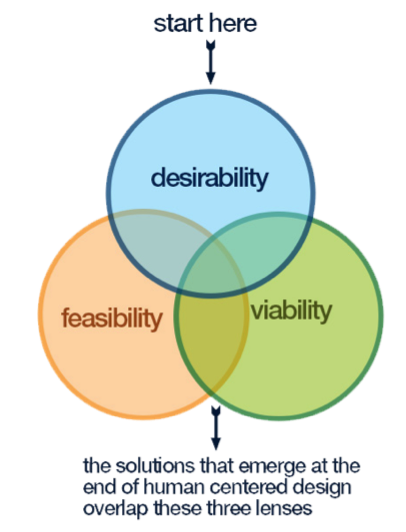Difference between revisions of "Human Centered Design Methodology"
From Learning and training wiki
| Line 1: | Line 1: | ||
{{Term|Human Centered Design Methodology| | {{Term|Human Centered Design Methodology| | ||
| − | Human Centered Design (HCD) is a process used to create new solutions for the world. These solutions can include products, services, environments, organizations and multiple modes of interaction. Human-Centered Design is used to overcome the poor design of software products. By emphasizing the needs and abilities of those who are to use the software, it improves the usability and understandability of products. The reason this process is called “human-centered” is because, as opposed to Activity-Centered Design, it starts with the people we are designing for. In other words it begins by examining the needs, dreams, and behaviors of the people through, what some call, the Desirability Lens.<ref>IDEO “Human Centered Design Toolkit” http://www.ideo.com/work/human-centered-design-toolkit</ref> | + | '''Human Centered Design (HCD)''' is a process used to create new solutions for the world. These solutions can include products, services, environments, organizations and multiple modes of interaction. Human-Centered Design is used to overcome the poor design of software products. By emphasizing the needs and abilities of those who are to use the software, it improves the usability and understandability of products. The reason this process is called “human-centered” is because, as opposed to Activity-Centered Design, it starts with the people we are designing for. In other words it begins by examining the needs, dreams, and behaviors of the people through, what some call, the Desirability Lens.<ref>IDEO “Human Centered Design Toolkit” http://www.ideo.com/work/human-centered-design-toolkit</ref> |
| Line 11: | Line 11: | ||
The process of human-Centered Design starts with a specific Design Challenge and goes through three main phases<ref>HCD Connect, “HCD Toolkit 2nd Edition” https://hcd-connect-production.s3.amazonaws.com/toolkit/en/download/ideo_hcd_toolkit_final_cc_superlr.pdf</ref>: | The process of human-Centered Design starts with a specific Design Challenge and goes through three main phases<ref>HCD Connect, “HCD Toolkit 2nd Edition” https://hcd-connect-production.s3.amazonaws.com/toolkit/en/download/ideo_hcd_toolkit_final_cc_superlr.pdf</ref>: | ||
| + | |||
• '''Hear''' the needs of the people and communities for whom you are designing. During the hearing phase, the designer conducts field research, collects stories, interviews, documentation, and seeks inspiration by spending time within the community. This phase does not consist in observation and interpretation only; instead it heavily involves the community members who act as participants. | • '''Hear''' the needs of the people and communities for whom you are designing. During the hearing phase, the designer conducts field research, collects stories, interviews, documentation, and seeks inspiration by spending time within the community. This phase does not consist in observation and interpretation only; instead it heavily involves the community members who act as participants. | ||
| Line 21: | Line 22: | ||
| − | '''Advantages<ref>http://jnd.org/dn.mss/human-centered_design_considered_harmful.html</ref>:''' | + | '''The Advantages<ref>http://jnd.org/dn.mss/human-centered_design_considered_harmful.html</ref>:''' |
| + | |||
• Designer adapts to the person or community. | • Designer adapts to the person or community. | ||
| + | |||
• Can overcome the poor design of products. | • Can overcome the poor design of products. | ||
| + | |||
• Improves usability and understandability of products. | • Improves usability and understandability of products. | ||
| + | |||
• Fewer errors during usage of products. | • Fewer errors during usage of products. | ||
| + | |||
• Faster learning times. | • Faster learning times. | ||
| − | '''Disadvantages<ref>http://jnd.org/dn.mss/human-centered_design_considered_harmful.html</ref>:''' | + | '''The Disadvantages<ref>http://jnd.org/dn.mss/human-centered_design_considered_harmful.html</ref>:''' |
| + | |||
• Software complexity still remains. | • Software complexity still remains. | ||
| + | |||
• Can lead to too specialized products, making its less appropriate for others. | • Can lead to too specialized products, making its less appropriate for others. | ||
| + | |||
• The focus upon humans may detract from supporting the activities themselves. | • The focus upon humans may detract from supporting the activities themselves. | ||
| + | |||
• Too much attention to the needs of the users can lead to a lack of cohesion and added complexity in the design. | • Too much attention to the needs of the users can lead to a lack of cohesion and added complexity in the design. | ||
Latest revision as of 02:36, 26 December 2014
|
Human Centered Design (HCD) is a process used to create new solutions for the world. These solutions can include products, services, environments, organizations and multiple modes of interaction. Human-Centered Design is used to overcome the poor design of software products. By emphasizing the needs and abilities of those who are to use the software, it improves the usability and understandability of products. The reason this process is called “human-centered” is because, as opposed to Activity-Centered Design, it starts with the people we are designing for. In other words it begins by examining the needs, dreams, and behaviors of the people through, what some call, the Desirability Lens.[1]
The process of human-Centered Design starts with a specific Design Challenge and goes through three main phases[2]:
• Can overcome the poor design of products. • Improves usability and understandability of products. • Fewer errors during usage of products. • Faster learning times.
• Can lead to too specialized products, making its less appropriate for others. • The focus upon humans may detract from supporting the activities themselves. • Too much attention to the needs of the users can lead to a lack of cohesion and added complexity in the design.
|
| Find below some additional resources. |
| Link | Content |
|---|---|
| Human Centered Design | Human Centered Design |
| Human Centered Design | Human Centered Design Methodology: and example of application with UAV's mission |
References
- ↑ IDEO “Human Centered Design Toolkit” http://www.ideo.com/work/human-centered-design-toolkit
- ↑ HCD Connect, “HCD Toolkit 2nd Edition” https://hcd-connect-production.s3.amazonaws.com/toolkit/en/download/ideo_hcd_toolkit_final_cc_superlr.pdf
- ↑ http://jnd.org/dn.mss/human-centered_design_considered_harmful.html
- ↑ http://jnd.org/dn.mss/human-centered_design_considered_harmful.html
